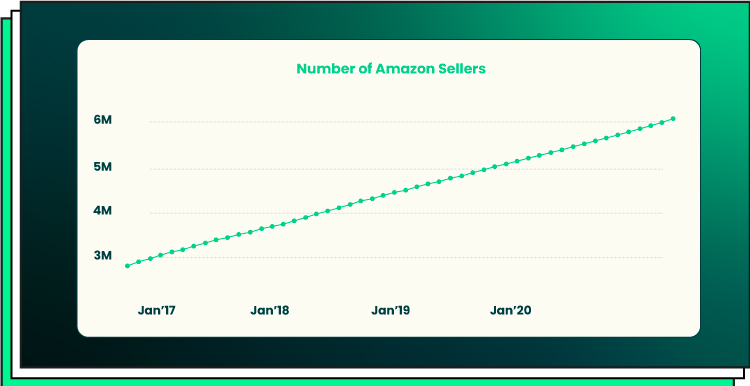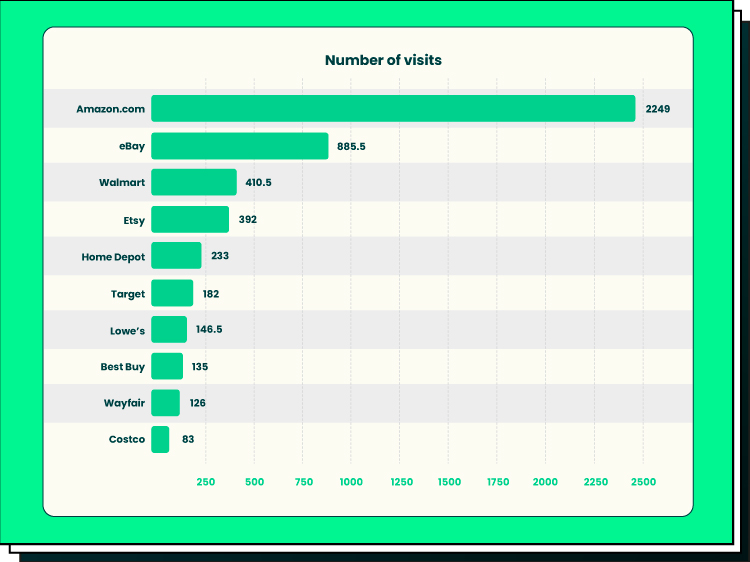Before the technological revolution, consumers’ purchasing decisions were based on the salespersons’ guidance and recommendations. But now, consumers conduct extensive research before the purchase and are equipped with data-driven knowledge which makes them much smarter in their experiences, while providing retailers with the possibilities to better understand consumers’ needs.
Moreover, the current pandemic has forced significant shifts in shopping behavior, and brick-and-mortar retailers have been backed into a corner. But even before COVID-19, retail stores were undergoing a rapid transformation, and their closings were caused by dramatic changes in consumer preferences: online shopping. According to Coresight Research, a global advisory firm in retail, more than 9,300 stores were closed in the US in 2019. In 2020, statistics represented a record of 12,200 U.S. closed stores ravaged by pandemics.
Nowadays, to sustain a dominant competitive market position in the retail sector, businesses have to shift their shopping paradigms and transit into new levels of big data in retail and e-commerce solutions. In the last few years, the retail market conditions have changed significantly which caused retailers to struggle with new challenges and adapt to the new ecosystem in order to ensure long-term survival and consumer surplus. McKinsey’s predictions are optimistic: retailers powered by big data can increase their operating margins by more than 60%. Indeed.
Among big data real-life applications, Amazon is a brilliant example of how an online business backed by big data can bring enormous results: 1,5 million active sellers and 2,45 billion monthly visits.

Walmart, the third company, surpassing 410 million monthly users, collects data on about 1 million transactions per hour, contributing to 2.5 terabytes of data.

With increased competition, mortar and brick retailers have been experiencing ripple effects from e-commerce stores following new and new approaches toward effective online presence. Are you in? How to leverage big data in shopping to understand the changing needs of consumers and respond to their needs? How to get the most out of retail consumer data? Read on to know how utilizing data patterns powered by AI models and ML can increase personalization, improve demand forecasting, and ultimately, enhance your profits.
How Big Data Is Changing Retail Marketing Analytics
To drive value for stakeholders, retailers need to consider the areas where they can apply advanced analytics.
Improved customer experience
While customers are permanently changing their preferences and purchasing behaviors, retailers have to adapt to them and adjust their marketing and sales strategies to make breakthrough decisions. The traditional customer engagement paradigm has shifted due to online research, comparison shopping, and demands for personalization.
In today’s competitive market, you do not need to wait for a customer anymore to find an offer. You can use big data in retail to target customers and apply smarter ways powered by AI/ML and IoT technologies to offer a personalized experience to them.
Whether it is a physical shopping mall or an online shop, you, as a retailer who meets your customer’s needs, have to understand the following:
- Which services and products are in demand?
- What makes your customers buy certain products?
- What offers are the most attractive to your customers?
- What can make them incentivized to make the right purchasing decision?
There is a myriad of possibilities (both for ecommerce and brick and mortar businesses) to collect and process data of your customers to obtain meaningful insights that can tremendously impact your sales decisions:
- IoT-based in-store data collection. IoT systems allow retail businesses to collect and manage data to find out more about customers’ journeys, their behaviors, and the most popular zones in the store, and transform this data into smart and valuable decisions. Via Bluetooth or WiFi devices and sensors, data is sent to the server for further processing. Furthermore, connected with ML algorithms, the IoT system provides retailers with loads of more solid analytical data to improve customers’ experience and lower operating costs.
- Personalized discounts and notifications. In the case of online offers, via transactional records and loyalty programs, retailers can collect a huge amount of data that helps them promote their products or upsell. Identifying the preferred ways for customers to interact and communicate with retailers via big data can help the latest offer a discount or particular promotion in a personalized way: whether by email or NFC sensor to send a loyalty discount.
Moreover, collected data on online customers’ searches can have an impact on their tailored experience in the store. Once customers step into your store, they will receive a notification about the discount for the product they were looking for yesterday, for instance. In such a way, you incentivize your customers to return.
- Advanced analytics powered by AI and AR. The British fashion retailer Asos developed the app with an image recognition feature to customize users’ needs and offer tailored solutions. By scanning any clothing item, a user sends it to the app to get similar products generated by AI. The same principle of big data in retail in the personalization-based marketing approach is used by IKEA. They also applied image recognition and AR (augmented reality) features to allow their customers to customize furniture in the app by virtually placing it in their homes.
Efficient supply chain and inventory management
There is a tremendous opportunity for retail businesses to leverage IoT technology to manage supply chain operations and inventory, improving collaborations between all the members of the supply chain cycle. Big data in retail ensures end-to-end data visibility across the entire ecosystem: from improving delivery times to fraud prevention. Supply chain predictive analytics augment data-driven decisions by monitoring performance and offering predictive models.
There is a range of issues and challenges in the SCM (supply chain management):
- Incorrect storage conditions
- Temperature-sensitive products
- Food waste
- Inefficient transport logistics
- Delivery delays
- Health concerns
- Product damages
- Stocking out/overstocking
- Fraud
Smart data-driven solutions help foster control over products and assets, efficiently analyze data, and retrieve comprehensive insights to prevent abnormal temperature levels, damages, spoilages, and inefficient inventory management which lead to inaccurate timelines and delays. Let’s take a look at some examples where big data in retail can bring value to your supply chain management.
- IoT-based asset tracking. This solution helps solve traceability issues throughout the delivery process, ensure efficient transportation operations in real-time, and streamline distribution. By applying, for example, RFID tagging, supply chain managers can accurately monitor and track inventory and product information. Therefore, having the opportunity to analyze all essential metrics (carriers, ship-to locations, contact details) and synchronize devices in real-time, retailers are empowered to increase asset utilization and enhance productivity.
- Predictive analytics and AI. Big data analytics leveraged with AI systems provide retailers with analytical predictions on sales trends and fluctuations. With predictive analytics, supply chain managers get the opportunity to forecast inventory demands, pricing distortion, shipment delays, etc. Possessing such predictive information, retailers can significantly lower costs. For instance, knowing how much is needed to optimize stocking shelves, will help prevent wasting the products.
Pricing optimization
Identifying the right price for the product requires precision and granular-level data. With big data analytics in the retail sector, retailers can analyze pricing accurately across different channels, customer segments, and stores and deliver it most predictably and strategically.
Big data plays an essential role in improving pricing decisions enabling retailers to compare various retail data sets.
To effectively optimize pricing points consider the following benefits of using big data in retail business operations:
- Big data helps adjust prices by creating granular-level demand models. The main mistake retailers tend to make when setting the price is that they align the prices to the merchandise category. Or even worse – when they only monitor ecommerce market trends and assess the competition. Big data predictive analytics allows for analyzing data at a granular level. With that said, we mean you can optimize pricing decisions based on historical data for separate products by, for example, clustering stores into zones and analyzing customers’ behaviors across the channels. Size, brand, and category role are also integral elements of the pricing strategy; however, big data can augment it by combining broad retail data sets.
- Predictive analytics facilitates effective discounts and promotions. It is important to know which product can be promoted at what period, when to reduce the price for certain products, and, ultimately, how to optimize markdowns. In this case, big data can be a magic wand. It provides smart insights based on the analysis of customers’ behavior and recent trends offering optimal price discounts for products during the right period. Moreover, pricing can be targeted based on customers’ demographic and psychographic profiles.
Shrinkage and fraud reduction
Fraudulent activities are another area where big data has enormous potential to mitigate risks and challenges. Retailers have to remain always alert in terms of monitoring financial transactions and control expenditures that are not economically viable.
According to Deloitte, big data analytics in retail can be applied in financial monitoring to detect unusual patterns and possible sources of fraud and prevent risks within organizations. In collaboration with different institutions (forensic teams, banks), retailers can use advanced analytics to reveal the areas with threats and issues:
- In the case of process-related errors in the point-of-service, data analysis can help identify losses.
- In conjunction with business intelligence systems, markdown systems, etc. big data analytics in retail helps business owners keep control over cash flows.
- In collaboration with banks, retailers can use analytics to prevent fraud before they are going to happen.
Forecasting trends and demand
With trend forecasting algorithms, marketers can analyze web browsing habits. Furthermore, powered by machine learning algorithms their strategies may be extremely strengthened. For example, data extracted from these analytical systems can pinpoint specific topics your customers are talking about on social media or on any other related platforms. Thus, you are equipped with accurate predictions about product categories and when they are likely to be in demand.
Moreover, with predictive analytics, you can get demographic data and economic indicators to analyze customers’ spending habits and correspondingly adjust your marketing strategy.
The evolution in data utilization predicted future sales much more dynamic and progressive. In contrast to old approaches when retailers relied mostly on the data of the previous years, tracking customers’ purchases, today’s strategies are based on AI algorithms that can precisely assess the customers’ environment and meet their needs.
Summary
In 2019, big data analytics in retail market size was valued at $4,43 billion, and in 2027, is anticipated to reach $17,85 billion. Yeah, it’s not shocking figures taking into consideration the rapid growth of the ecommerce market, which triggered retailers to be more sophisticated in their approaches toward customer engagement and loyalty.
Predictive analytics empowers retailers to retrieve valuable insights from big data in retail to accurately forecast demands, enhance customer experiences, efficiently control processes throughout the entire supply chain cycle, identify optimal pricing models, and finally, streamline all business processes.
If you are looking for specialists who would help you in building your ecommerce solution tailored to your specific needs, get in touch with us to discuss your project.







